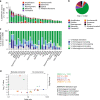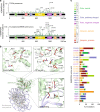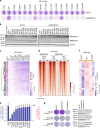Functional characterization of SMARCA4 variants identified by targeted exome-sequencing of 131,668 cancer patients
- PMID: 33144586
- PMCID: PMC7609548
- DOI: 10.1038/s41467-020-19402-8
Functional characterization of SMARCA4 variants identified by targeted exome-sequencing of 131,668 cancer patients
Abstract
Genomic studies performed in cancer patients and tumor-derived cell lines have identified a high frequency of alterations in components of the mammalian switch/sucrose non-fermentable (mSWI/SNF or BAF) chromatin remodeling complex, including its core catalytic subunit, SMARCA4. Cells exhibiting loss of SMARCA4 rely on its paralog, SMARCA2, making SMARCA2 an attractive therapeutic target. Here we report the genomic profiling of solid tumors from 131,668 cancer patients, identifying 9434 patients with one or more SMARCA4 gene alterations. Homozygous SMARCA4 mutations were highly prevalent in certain tumor types, notably non-small cell lung cancer (NSCLC), and associated with reduced survival. The large sample size revealed previously uncharacterized hotspot missense mutations within the SMARCA4 helicase domain. Functional characterization of these mutations demonstrated markedly reduced remodeling activity. Surprisingly, a few SMARCA4 missense variants partially or fully rescued paralog dependency, underscoring that careful selection criteria must be employed to identify patients with inactivating, homozygous SMARCA4 missense mutations who may benefit from SMARCA2-targeted therapy.
Conflict of interest statement
T.M.F., R.P., R.B., Q.Z., H.T., S.M., M.K., S.C., Z.M., T.J. and R.L.Y. are employees of Genentech and own shares of Roche. E.S.S. and S.E.T. are employees of Foundation Medicine and own shares of Roche.
Figures





References
MeSH terms
Substances
LinkOut - more resources
Full Text Sources
Other Literature Sources
Medical
Molecular Biology Databases
Research Materials
Miscellaneous

